
Introduction of Lean to Roof
If you are planning to build a new house then it is very important that you should select one of the best roof for your structure because roof is one of the most important parts of the structure which protects the structure from rain, sunlight and aggressive environmental conditions.
Lean-to roof is one of the best and most commonly used roofs for the structure. The lean-to roof is very easy to construct and economical as compared to the other types of roofs.
In this article, we will be discussing about Lean to roof, how to build lean-to roof structure, advantages and disadvantages of the lean-to roof structure.
What is Lean to Roof?
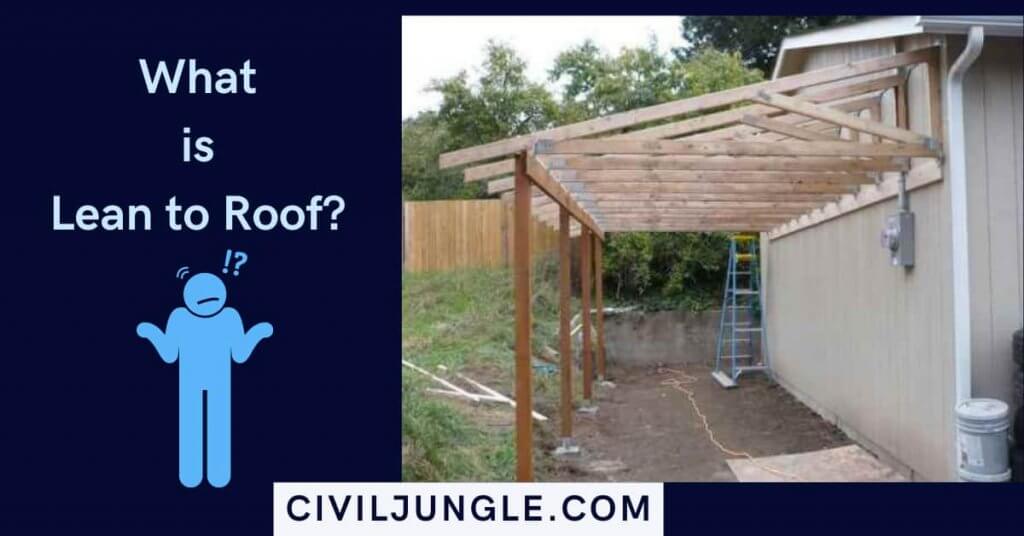
A lean to roof can be defined as a roof that has only a single slope with its upper edge adjoining a wall or a building. It is a simplest type of pitched roof which is also known as the sloping roof.
Lean-to roof is one of the commonly used roofs for covering the various types of structures. The Lean-to roof is also known as one side roof because it is generally used to cover one side of the structure such as verandah.
Lean to roof is basically a free-standing structure in which the wall of one side is built at a more height as compared to the wall at another side. The lean-to roofs are widely used in the construction of the verandahs, sheds and go downs.
How to Build Lean-to Roof Structure?
The step by step procedure to build the Lean-to roof structure are as follows.
- Before starting the construction of the building it is necessary to do the site clearance and cut out all the trees and levelled the ground.
- The Marking of the foundation should be done on the site as per the plan.
- Then the excavation work should be carried out for the construction of the foundation.
- Dig the holes for the installation of the supporting posts. Ensure that the posts should be in the vertical direction.
- After installing the post holes into the ground, it should fix with concrete so that it cannot move from its position.
- In the lean to roof structure, the upper side of the rafters are rested on the wooden plate which is placed on the corbel.
- A corbel is basically a projection that comes out of the wall in order to support the structure which is resting on it. The corbel is a weight carrying member which is generally made up of stone or wood.
- The lower ends of the rafters are nailed and notched. The rafters in the lean-to roof are rested at an angle of 30 degrees at a wall.
- Notch the upper side of the post holes so that the rafter can be easily fitted or rest on it. After that set the nailery on posts.
- Fasten the nailery on the wall which has a higher length so that there you can attach the upper end of the rafter.
- The rafters should be properly attached and fixed to the wall. Then mark out the spacing of the rafter on the mailers.
- Determine the slope of the roof by stringing a line from the top side of the rafter towards the bottom side of the rafter.
- Attach all the rafters and fixed it properly. Then cover the roof by using suitable roofing material as per your requirement.
- There are various types of roof covers are used in the construction of the Lean-to roof such as A.C sheets or pre-coated sheets and Mangalore tiles etc.
Materials Which Are Used for the Construction of the Lean-to Roof
There are various types of materials are available in the market which you can use for the construction of the lean-to roof. Some of the commonly used roofing materials are as follows.
1. Clay Roof Tiles
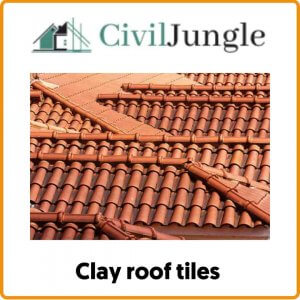
- The clay roof tiles are made up of baking moulded clay which are available in different types of colours such as white, orange and brown etc.
- This clay roof tiles are more durable as compared to the other types of roof tiles.
2. Glass Roofing

- Glass roofing is one of the best roofing options which allows natural sunlight to enter into the structure.
- This also enhances the aesthetical look of the structure.
- But the transportation of the glass roof is difficult and there may be a chance of breaking.
3. Polycarbonate Roof

- Polycarbonate sheets are very lightweight and very easy to carry from one place to another place.
- The polycarbonate has good impact resistance.
- Polycarbonate is a highly flexible material so that it can be moulded into various shapes as per the requirements of the construction.
4. Concrete Tiles

- The concrete tiles are very affordable as compared to the other types of tiles.
- It has good strength and durability.
5. Asphalt Shingles
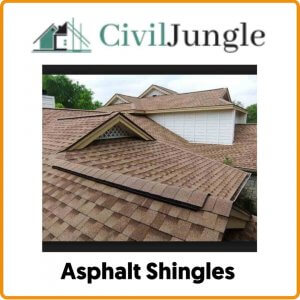
- Asphalt shingles are one of the oldest roofing materials which are used in construction.
- The asphalt shingles have good resistance to fire.
6. Metal Roofing

Metal roofing is versatile in design and style which requires very little maintenance and is available in various types of colours.
Advantages of Lean To Roof
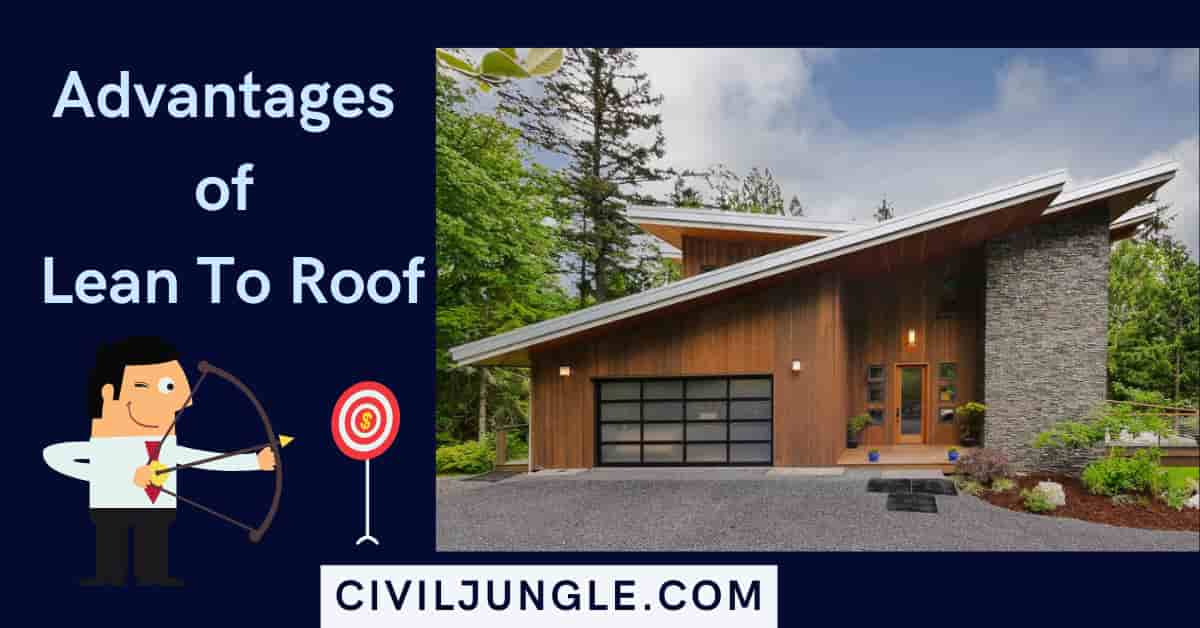
There are various advantages of lean-to roof which are as follows.
- The construction process of the lean-to roof is very easy and economical as compared to the other types of roof structures.
- The construction process of the lean-to roof structure is very easy and affordable as compared to the other types of roofs.
- The lean-to roof has a steep slope which helps to drain off the rainwater quickly.
- The Lean-to roof also avoids the pooling of snow which can damage the structure or also create the problem of leakage.
- You can also install Solar panels on this type of roof.
- We can use various types of roofing materials in the lean-to roof as per our requirements.
- In case of the lean-to roofs the rainwater can be easily collected.
Disadvantages of Lean to Roof
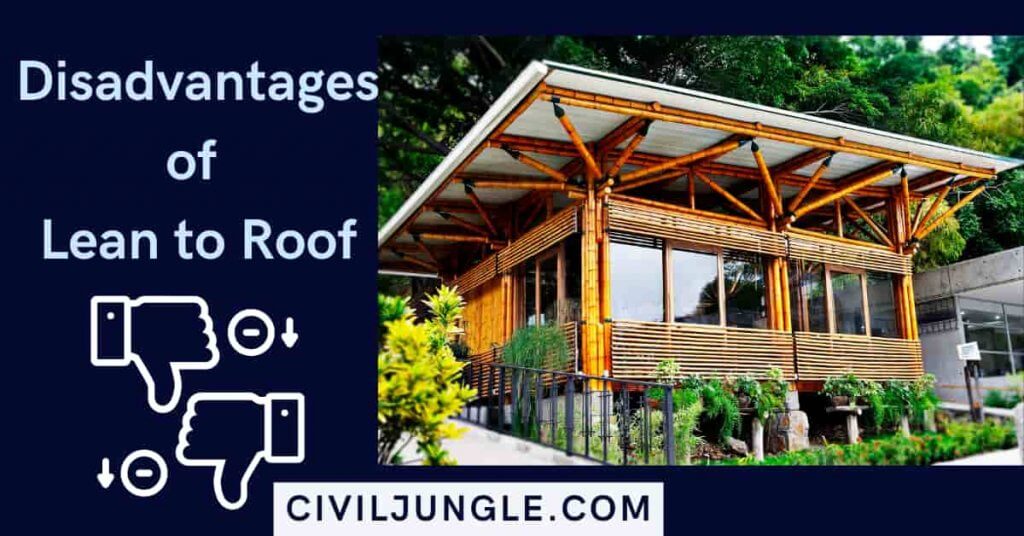
There are also some disadvantages of lean-to roof which are as follows
- The Lean-to roofs are not suitable for the construction of large structures.
- The lean-to roofs have only one slope that’s why it may create the problem of water drainage when there will be heavy rainfall.
- In case of the lean-to roof the ceiling, itself takes the same slope as the roof that’s why there will be very little attic space.
- These types of roofs are not suitable for the areas where the wind flows with a very high velocity, it may lift up the roof.
- It requires more maintenance as compared to the other types of roofs.
- It is not possible to construct above in case of lean-to roof structures.
How to Build a Free Standing Lean to
Here are some steps for building a free standing lean-to:
- Choose a spot for the lean-to, such as a small clearing with two large trees about five feet apart
- Gather materials, such as three long pieces of wood for the frame
- Assemble the frame by tying the three pieces of wood together to make an arch shape
- Anchor the posts into concrete, about 3-6 feet deep
- Attach support braces
- Install the rafters
- Add roofing material and finish
You can also save on materials if the lean-to abuts an existing exterior wall. Lean-tos can cost around $15 to $17 per square foot, depending on whether it’s open or enclosed.
You’ll need materials such as 2x4s, asphalt shingle roofing, metal framing brackets, door hinges and latch, galvanized nails and outdoor screws, and paint, stain, or preservative.
Conclusion of Lean to Roof
Roof is one of the important parts of our home so the selection of the type of roof on our depends on the various factors such as the budget, design of our home and the environmental conditions of the area.
So, it is recommended that you should take all the pros and cons of the particular roof into consideration while the selection of the roof.
The Lean to roof is the best option for the construction of small homes or sheds. Lean-to roof proves to be beneficial when it will be used in heavy rainfall areas.
Frequently Asked Questions (FAQ) About Lean-To Roofs
What Is a Lean-To Roof?
A lean-to roof is a simple type of pitched roof with a single slope that attaches to a wall or building. It’s also known as a sloping roof or one-sided roof, commonly used to cover structures like verandahs, sheds, and small additions.
What Are the Main Advantages of a Lean-To Roof?
The main advantages include its ease and affordability of construction, effective rainwater drainage, prevention of snow pooling, and compatibility with various roofing materials. It also allows for the installation of solar panels.
Are There Any Disadvantages to Using a Lean-To Roof?
Yes, some disadvantages include limited suitability for large structures, potential drainage issues during heavy rainfall, minimal attic space due to the roof’s slope, and higher maintenance requirements compared to other roof types.
What Materials Can Be Used for a Lean-To Roof?
Common materials include clay roof tiles, glass roofing, polycarbonate sheets, concrete tiles, asphalt shingles, and metal roofing. Each material has its own benefits regarding durability, aesthetics, and ease of installation.
How Is a Lean-To Roof Constructed?
The construction involves site preparation, marking and excavating for the foundation, installing vertical posts, attaching rafters to a wooden plate and corbel, and covering the roof with suitable materials. The process includes ensuring proper alignment and secure fixing of all components.
Can a Lean-To Roof Be Used for Large Buildings?
Lean-to roofs are generally not suitable for large buildings due to their single slope design, which can cause drainage issues and limited structural support.
How Much Does It Cost to Build a Lean-To Roof?
The cost typically ranges from $15 to $17 per square foot, depending on whether it is open or enclosed, and the materials used. Costs may vary based on local labor rates and material prices.
What Is a Free-Standing Lean-To, and How Is It Built?
A free-standing lean-to is a lean-to roof structure that does not attach to an existing wall but stands independently. It involves choosing a location, assembling a frame, anchoring posts in concrete, attaching support braces, and installing roofing material.
Can a Lean-To Roof Be Used in High-Wind Areas?
Lean-to roofs may not be ideal for areas with high winds, as their single slope can be more susceptible to wind uplift. Proper reinforcement and construction techniques are necessary to address these concerns.
How Do I Maintain a Lean-To Roof?
Regular maintenance involves checking for damage, clearing debris, inspecting the condition of the roofing material, and ensuring proper drainage to prevent water pooling and leaks.

